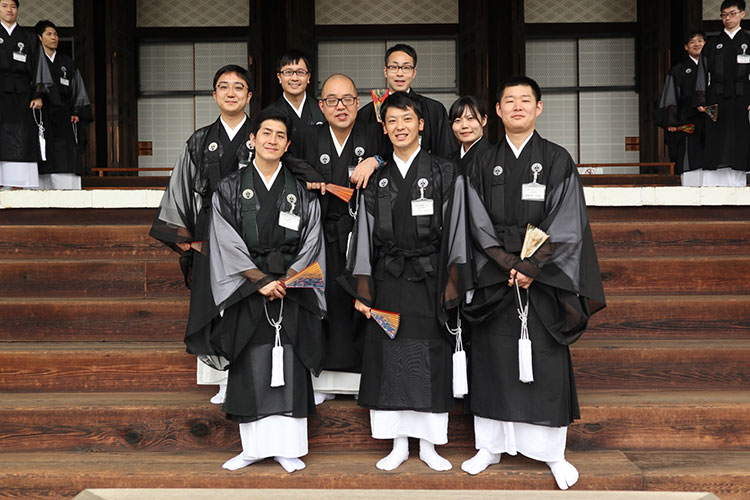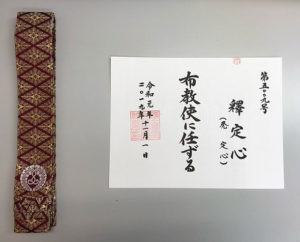
Rev. Joshin Kamuro (front left) with fellow Missionary Training program participants at Honzan (Jodo Shinshu world headquarters temple) in Kyoto, September 2019
The following is Rev. Joshin Kamuro’s first Dharma message upon returning from a 5-month Missionary Training program in Kyoto, Japan. He is now qualified to give Dharma talks the Hongwanji world headquarters in Kyoto and Tsukiji Hongwanji in Tokyo. A PDF version of the talk is available.
Let Us Sing Ondokusan with Sign Language
Page references:
Ondokusan Ⅰ p. 106: Sing Namo Amida Butsu Gatha Book
Ondokusan Ⅱ p. 107: Sing Namo Amida Butsu Gatha Book
Please join me in Gassho, and let us bow our heads in reverence.
Shinran Shonin’s words:
如来大悲の恩徳は 身を粉にしても報ずべし 師主知識の恩徳も ほねをくだきても謝すべし
“Such is the benevolence of Amida’s great compassion, That we must strive to return it, even to the breaking of our bodies; Such is the benevolence of the masters and true teachers, That we must endeavor to repay it, even to our bones becoming dust.”
(CWS P. 412, Hymns of the Dharma-Ages, Shozomatsu wasan)
(Ondokusan I P. 106: Sing Namo Amida Butsu, Gatha Book)
Namo Amida Butsu.
“By the Benevolence of Amida’s Light,
How in utmost we entrust deep thanks express;
For our debt to teachers for their guidance true,
We dedicate ourselves in gratefulness.”
(Hawaii Music Committee’s Gatha Translation Subcommittee)
Good morning, everyone!
Thank you very much for attending the Sunday Service this morning. It has been 5 months since I last saw you in April. I was in Kyoto, Japan and returned to Hawaii on September 13th, 2019.
Thanks to the support of Bishop Matsumoto, Rimban Hagio, Betsuin Ministers, the staff and you, the members, and last but not least my dear wife, Minako and son, Yuma, I was able to complete the program of Missionary Training at the Dendo-in Dormitory of the Hongwanji in Kyoto.

Rev. Kamuro’s appointment certificate of Fukyoshi, certifying him as a specialist in delivering Dharma messages. Click image for a larger view of the certificate.
I passed the final demonstration of Dharma Talk that I gave on September 9th. And, just last Monday, I received the notification of success from the Hongwanji. If I had failed the final test, I might have been sick in bed today. Here is my certificate for the completion of program and this is the notification of success in the demonstration test.
Today I am wearing my happy face, so glad I am, to be able to give you a good report. This would not have been possible without your kind support and understanding. Thank you very much for your help and kind support that my family and I received throughout the 5 months period of program.
Now I am qualified to give Dharma talks at the Hongwanji in Kyoto and Tsukiji Hongwanji in Tokyo. The best part of the program was that I received direct individual guidance from instructors who are experts on Dharma talks. They taught me the basic structure of the Dharma talks and how to convey the Jodo Shinshu teachings accurately.
Just as composers take great effort to create music for the enjoyment of their listeners, ministers need to put a lot of thought into their Dharma talks so that people receive the wisdom of the Dharma and the joy of Amida’s great compassion. I know it is not easy, but I will keep working hard and do my best for our members and community.
This morning, at first I would like to mention the passing away of my brother in law which happened in Mie prefecture, last month. Then, I would like to share Ondokusan in sign language, which I learned, as part of the Missionary Training at the Hongwanji in Kyoto.
On August 5th, I was at the Dendo-in Dormitory of the Hongwanji. When my wife, Minako called and I was suddenly informed that her sister lost her husband who was only 37 years old. His name was Kenji and his nick name was Ken-chan. Ken-chan died of stroke at his new family home in Mie prefecture, Japan. My sister in law, Atsuko and Ken-chan have two daughters: the 1st daughter is 8 years old, and the 2nd daughter is 6 years old.
I heard myself saying, “It cannot be true. That’s not him, you must mean Ken-chan’s father, don’t you?” My wife said, “No! It is Ken-chan.” I was speechless with shock for a while. I couldn’t believe it.
Last year, Ken-chan and his family came to Hawaii to attend his brother’s wedding ceremony in Oahu. When they had free time, they visited us. And we had dinner together at our residence. He brought a nice pair of basketball shoes to my son as a gift, because he knew that my son likes basketball. Yuma really likes those shoes and plays basketball with those shoes always.
It is very hard to accept the death of a family member. But death is a matter of fact. It is a reality in human life. It teaches us to be kind for we never know when we may be having our last meeting with someone we care about.
On behalf of my family, I wanted to express our condolences to my sister in law, Atsuko, and I would like to say “Thank you and Good-bye” to Ken-chan. So I attended his funeral service and pre-cremation service in Mie on August 8th. At that time I was in Kyoto, so I could attend the services. At the crematory, I said to him “Good-bye and see you again in the Pure Land.”
When I offered Koden (condolence money) to my sister in law, Atsuko, I wrote Rev. Daiei Kaneko’s words on the envelope. I shared his words with her:
“What saves one from sadness is sadness that knows sadness.
What saves one from tears are tears washed away by tears.”
悲しみは 悲しみを知る 悲しみに救われ 涙は 涙にそそがれる 涙にたすけられる
Through his words, I realize how Amida’s great compassion is working for us. When we feel sad, Amida Buddha also feels sad. When we are crying, Amida is also crying with us. Amida Buddha knows our sadness in life.
When I say Namo Amida Butsu, simultaneously I also listen to Amida’s calling voice; “I always stand by you in difficult times. Please don’t worry. I will protect you.” Through the calls of Amida Buddha in the Nembutsu, I realize that we all are embraced by Amida’s great compassion no matter how difficult a situation occurs.
Of course, the death of a family member is very sad, but in Amida’s embrace, we are able to walk the path of the Nembutsu, which leads to the Pure Land where we can meet again.

Click image for instructional sheets showing the Japanese sign language for Ondokusan (PDF document).
Now I would like to share Ondokusan in sign language, which I learned, as part of the Missionary Training at the Hongwanji in Kyoto. Here at Hawaii Betsuin, Ondokusan is sung in both English and Japanese for our Sunday Services sometimes, so some of you may know this song.
In Japan, at the hall of the Dendo-in Dormitory, every evening services we sang this song. After I learned Ondokusan in sign language, I looked forward to singing it every evening services, because I appreciate more the meaning of it.
Sign language teaches me each word of Ondokusan. So I would like to introduce Ondokusan in sign language to you so that you may also appreciate more the deep meaning of Ondokusan like me.
Before I sing and sign language, I would like to read the English translation of Ondokusan. Please open your white Gatha Book “Sing Namo Amida Butsu” to page 106 and 107. You can see two musical scores OndokusanⅠon page 106, and OndokusanⅡon page 107.
Ondokusan was written by Shinran Shonin at the age of 86 in 1258. OndokusanⅠ(the old version) was composed by Rev. Yasuo Sawa in Hawaii in 1918. Rev. Yasuo Sawa was an Associate minister at Hawaii Betsuin from 1918 to 1921. OndokusanⅡ(the new version) was composed by Mr. Osamu Shimizu in 1952. He was born in the Shinshu Ohtaniha temple in Osaka.
As you noticed, there are two English translations of Ondokusan on page 106 and 107. Today I’d like to read it on page 106, which is the English translation in Collected Works of Shinran. Please look at the bottom of the page 106. Let us read it together with me.
“Such is the benevolence of Amida’s great compassion,
That we must strive to return it, even to the breaking of our bodies;
Such is the benevolence of the masters and true teachers,
That we must endeavor to repay it, even to our bones becoming dust.”
Thank you. I think that many people feel this is a very strong statement of Shinran Shonin. Especially the lines “even to the breaking of our bodies”, and “even to our bones becoming dust,” Shinran Shonin said “we must repay the benevolence of Amida’s compassion and the masters.” How powerful his statement is. He expressed his deep gratitude for Amida Buddha and the masters.
Now I will sing and sign language the song in Japanese once. Please join me in singing and signing the second time. Let us express our gratitude for Amida Buddha and the masters by singing and signing.
| 如来 | Amida Buddha |
| 大悲 | great compassion |
| の恩徳 | benevolence |
| は | receiving |
| 身を | body |
| 粉にして | smashing and breaking |
| も | even though |
| 報 | gratefulness |
| ずべし | must dedicate |
| 師主 | the masters |
| 知識 | guidance |
| の | teachers |
| 恩徳 | benevolence |
| も | and also |
| ほねを | bones |
| くだきて | becoming dust |
| も | even though |
| 謝 | Thankfulness / appreciation |
| すべし | must express |
Thank you very much for singing and signing language with me.
I would like to close with reciting the Nembutsu, Namo Amida Butsu, together. Please join me in gassho and let us recite the Name, Namo Amida Butsu, together.
Namo Amida Butsu. Namo Amida Butsu. Namo Amida Butsu.
Thank you very much for listening to my message this morning.
Additional page references:
Gratefulness Ⅱ p. 8 : Translated Gathas 2009
Ondokusan Ⅱ p. 134: Jodo Shinshu Service Book


